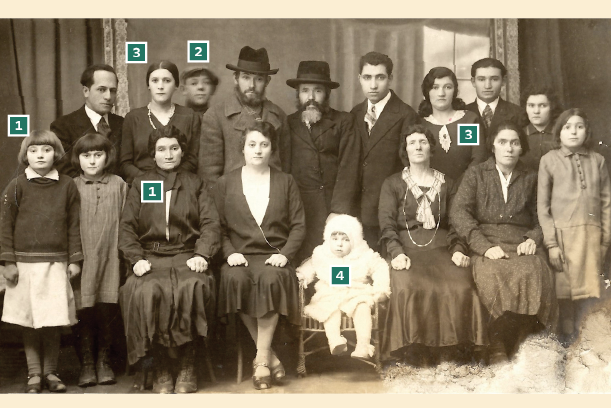Sign up for the Family Tree Newsletter Plus, you’ll receive our 10 Essential Genealogy Research Forms PDF as a special thank you!
Get Your Free Genealogy Forms
"*" indicates required fields
Finding out who’s in an old family picture gets more complicated when records are missing, ancestral hometowns destroyed and few relatives remain to offer clues. Of the 17 faces in this photo, Nina Hoffer knows the names of only two people. The rest are mysteries.
Hoffer’s grandmother Hinda Braun Linder sits in the center next to her son, Saul. Hinda immigrated with her husband Schulim to Manitoba from Radziechow, Poland, in 1921, shortly before her parents died in 1922 and 1923. The family kept in touch across the Atlantic until World War II, when the letters abruptly stopped. Nina’s family thinks the unknown people in this image died in the Holocaust.
Radziechow, formerly part of the Austrian Empire, is now known as Radekhiv, Ukraine. Camp Belzec, a Nazi extermination camp in operation from March 1942 to June 1943, was located nearby. Of the 2,000 Jews living in Radziechow, only 26 survived the Holocaust. Four of those were relatives of Hinda’s mother.
Hoffer’s aunt (and Saul’s sister), who owns this image, identified Hinda and Saul and said Schulim was a fur trader who may have been born in Hungary. Records have been elusive: All Hoffer has is a translation of Schulim’s will leaving his property to Hinda and miscellaneous household goods to his unnamed brother’s children, Moses, Hersch and Symie.
When relatives moved away, no one knew if they’d ever be seen again. Families would often sit for a pre-migration photo as a memento for both the immigrant and the family left behind. This photo, though, was likely taken in 1931, when Hinda returned home to sell her father’s house.
Hoffer hopes DNA testing will help her find surviving cousins. She’s also examining the clues in this picture, detailed below.

- The people in this photo have many similar facial features. For example, the young girl on the far left is the spitting image of the woman next to Hinda. It’s likely that other Braun siblings, their children and perhaps grandchildren are depicted in this image.
- This young man, who’s blurry and less carefully posed than the others in the photo, either moved suddenly or jumped into the picture at the last minute.
- Dresses in the 1930s featured lace collars like the ones on the women on the right. The woman on the left in the back row wears makeup like film stars of the era.
- Hinda’s youngest child is the center of attention in this photo; her four other children aren’t present. The reason may tell the story of this photo.
From the October/November 2015 issue of Family Tree Magazine
ADVERTISEMENT

